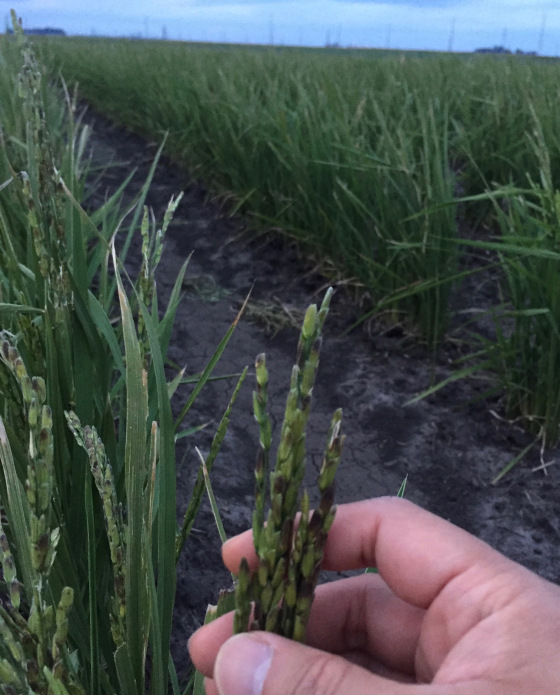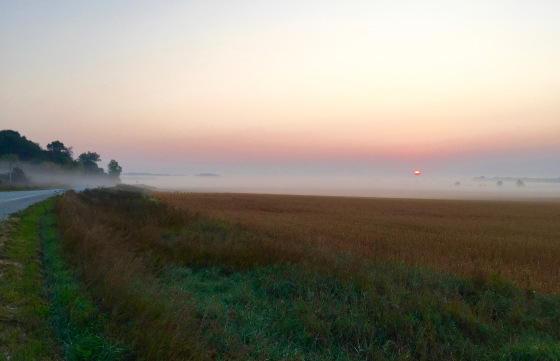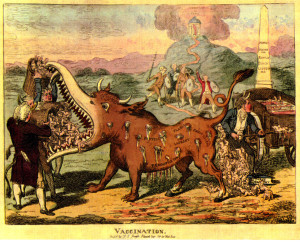A few weeks ago, we visited a friend’s farm where they are experimenting if they can grow rice here in Iowa. In case you don’t know, we don’t plant rice here. The farms here in Iowa are mostly corn and soybeans. Though rice is grown in a few southern states of the US.
The rice that they are trying to grow here in Iowa is a different type of rice though. As you can see in the picture below, it is not growing in paddies that we Filipinos are more familiar with. This variety of rice is more sturdy to the cold weather and does not need irrigation or much water. Of course the part owner of this farm is a Filipino. As we Filipinos loves rice, where ever part of the world we are.

Back in the Philippines, even though I grew up in the city, we went to my father’s province quite regularly when I was young. Their ancestral home was by the edge of a rice field. We spent many hours watching farmers work on those fields. We sometimes played in those fields too, hunted for palakang bukid (frogs) there, and even played tag with my cousins while running in the pilapil (dikes).
During harvest season, it was beautiful to see the palay (rice) with their golden grain swaying and dancing as the wind blows through them like the waves of the sea. I miss seeing those fields of palay.
In 1993, one of my favorite singers, Sting released the song “Fields of Gold.” The song opens and ends with these words:
You’ll remember me when the west wind moves
Upon the fields of barley
You’ll forget the sun in his jealous sky
As we walk in fields of gold.
Sting found inspiration to write that song as his house in England, a 16th century Wiltshire manor house, was surrounded by barley fields. Even though I am not familiar with fields of barley, I can somehow relate as I have seen “golden” fields of rice, which I believe has the same poetic appeal.
If Sting lived in the Philippines, he could have sung: “You’ll remember me when the west wind moves, upon the fields of palay.” And if he grew up in the Philippines, his name may not be Sting, but it could be Pagi (stingray), or Putakti (wasp), which we know can sting bad. Sorry I digress.
By the time the song Fields of Gold became popular, it was the time also that I left the Philippines. You could say that I left my native land in search of some greener pastures and in pursuit of “fields of gold.”
When I came to America, the first couple of CD’s I bought was albums of Sting. For several months, during my lonely moments, Sting kept me company. I listened to his melancholic songs of Fragile and They Dance Alone, and also sang along his upbeat songs like All This Time and If You Love Somebody Set Them Free. Sometimes he even serenaded me to sleep.
After living here in the US for some time, and after moving from New Jersey, then to New York, then to California, then to Florida, and finally settling here in Iowa, I believe I have found what I was looking for. I can even claim now that I am literally looking at fields of gold. With autumn season upon us and with changing fall colors, even the fields here are turning gold, signifying that harvest time is near.
Below is a picture of a ‘golden’ soybean field.

I may have traveled long and far in pursuit of my dreams, but at least I can say that it brought me to my own fields of gold. I am not saying that I own those soybean fields. I don’t own corn fields either. I am not even talking about the soybeans, or cornfields, or even those rice fields. What I’m saying is this – what I own, is the realization of my dreams.
As I was running the other morning near these golden fields, the song Fields of Gold was playing in my mind. And if I may borrow from the lyrics of Sting, albeit with some changes:
Many years have passed since those summer days among the fields of barley palay
See the children me as I run, as the sun goes down up among the fields of gold.

(*photos of soybean fields taken during my morning run)
Like this:Like Loading... Related





